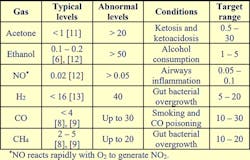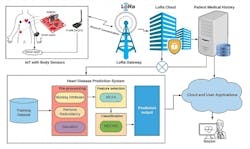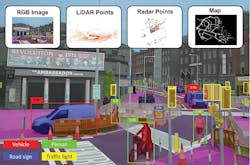As MEMS and sensor fabrication design progresses, we must not forget to direct our attention to the many other innovative techniques that enhance sensor accuracy and performance. This article will discuss various methods for improvements using unique sensor calibration as well as alignment, integration, deep learning, and added functionality.
Breath Analysis1
Metal-oxide (MOx) chemiresistors are perfect for gas sensing because of their small size, low power, and low cost. These are a class of chemical resistors that function via direct chemical interaction between the sensing material and the analyte (the substance whose chemical constituents are being identified and measured).
Human breath analysis can provide for improved health and wellness as well as other biomedical applications. It’s incredible what conditions can be detected in the gases within an exhaled breath (Fig. 1).
A key challenge in the accuracy of gas measurements is cross-sensitivity, a condition in which a sensor responds to other gases that aren’t filtered out and thus are able to react on the electrode. One solution is to have an array of independently driven chemiresistors that will improve on the cross-sensitivity and drift errors. By driving each of the different MOx coatings at different temperatures or using different materials for each MOx, the overall system can combine the responses from each of the sensors in a unique algorithm that will improve the measurement accuracy.
One example would be drift correction via the resistance output from two identical MOx devices operating at the same temperature. Also, to improve the output stability of the individual MOx outputs, it would be advisable to add a feedback loop that will maintain constant heater resistance, which will keep the temperature constant at a desired value as well.
Breath analysis is a different situation. If we combine a gas and a flow sensor in the design, the flow sensor will be able to compensate for the effects of flow while the gas sensor measures the target gas. This will ensure measurement accuracy and reproducibility.
Reference 1 demonstrates an integrated monolithic IC that’s composed of three gas sensors and one flow sensor with the addition of a controlled independent microheater.
Gas and flow testing3
Sensors are tested at different temperatures to find the best operating range for each different MOx material. Two methods of measuring gas-flow velocity can be used, using a calorimetric (for the gas-flow velocities exceeding 1 m/s) or thermo-anemometric method (for the gas-flow velocities less than 1 m/s).
Prediction of Heart Disease2
Lowering the death rate from heart disease, the leading cause of deaths worldwide, is of critical importance in the world of health and wellness. Doing this effectively is difficult because it will require experience and advanced knowledge. The good news is that we now have the Internet of Things (IoT), which has progressed in terms of data collection. It’s used extensively in collecting sensor values for both heart disease diagnoses and predictions with wearable monitoring.
Since we find that the accuracy of diagnosis is pretty low, Reference 2 proposes an IoT framework that can accurately evaluate heart disease using a technique known as Modified Deep Convolutional Neural Network (MDCNN) (Fig. 2).
Take, for example, a smartwatch and a heart monitor device (an AD8232 heart-monitor board), that when attached to a patient, senses blood pressure and monitors an electrocardiogram (ECG). MDCNN is used to place this received sensor data into classifications of either normal or abnormal. System performance can be analyzed via comparing the MDCNN with existing deep-learning neural networks and logistic regression.
Training phase
For training, the data from the University of California Irvine (UCI), Framingham, on coronary heart disease (CHD), along with Public Health Dataset, is utilized. The MDCNN classifier is employed to train the system.
Testing phase
After training, the testing phase is executed. The simulation of the proposed IoT framework for the heart disease prediction system is employed using the Python, Android, and Java platforms.
The sensor device joined to the patient continuously sends sensor values. These are classified based on the training outcomes, which means that the sensor values from the IoT are contrasted with the values of the training phase. The system compares the values and provides classified outcomes.
The results of this method show a 98.2% accuracy, which proves better than any other existing classifiers.
Improved Object Detection for Autonomous Driving4
Perception in autonomous vehicles is a critical feature that’s essential to safe operation on the roads. Deep learning, an artificial-intelligence (AI) function, imitates human brain functions in processing data and creating patterns, leading to decision-making. This goal of this new area of machine-learning (ML) research is to move ML toward AI.
Autonomous vehicles need an accurate and robust understanding of scenes—the use of various sensors, such as LiDAR, radar, and RGB cameras, coupled with maps, provide perception to these vehicles. Fusion of these multi-modal signals can take advantage of these sensors’ complementary properties (Fig. 3).
The key focus in this arena is on object detection and semantic segmentation:
Deep object detection
Detecting objects requires recognizing and localizing multiple objects in a scene. Figure 3 shows objects recognized by estimation of a classification probability and by localizing with bounding boxes.
Deep semantic segmentation
The workings of semantic segmentation is done with partitioning of a scene into various meaningful parts. Each pixel in the image is labeled with semantics known as pixel-level semantic segmentation, or via simultaneously detecting objects and performing a per-instance per-pixel labeling known as instance-level semantic segmentation. Semantic segmentation had its beginnings in camera image processing.
Some datasets for semantic segmentation are Cityscape, which is a diverse set of stereo video sequences recorded in street scenes from 50 different cities, KITTI for vision benchmarking (especially for autonomous vehicles), and Toronto City to name just a few.
Testing and Simulating Deep Learning
Testing is the fundamental way to maintain code. Testing deep learning code is challenging. For more on this, check out the article “How to Test Deep Learning.” Also, MathWorks has an excellent tutorial on deep learning, specifically on how to create and train deep-learning models.
Many challenges and open questions still remain regarding accurate object detection. We’re only beginning to scratch the surface. Nonetheless, LiDAR, radar, and cameras (including thermal and infrared) are the sensor-related devices at the forefront of safe autonomous-vehicle operation. The software is always the most complex and time-consuming task in most design architectures and must be refined until it can be deemed highly functional and safe to use, especially in a busy urban environment.
When we can test and run autonomous vehicles safely over an extended period in such cities as New York City, Chicago, and Los Angeles, then we’re ready for “prime time” on the streets of the world.
Summary
MEMS and sensors are at the very heart of improving health and safety with electronic-system architectures. Sensors, at the front end of a system, act as our eyes to see, ears to hear, nose to smell, hands and body to touch, and tongue to taste. Analog signal conditioning makes sensors ready to enter the digital domain in which the processors and software take over and perform their magic. Test and measurement of these systems define the readiness and accuracy/usefulness for the system architecture to perform its task(s) for human health and safety in our world.
References
1. C. Zuliani, J. Luque, C. Falco, E.L.W Gardner, A. De Luca, T.A Vincent, S. Tripathy, Z. Ali, F. Udrea, “Flow Compensated Gas Sensing Array for Improved Performances in Breath Analysis Applications,” IEEE Sensors Council, IEEE Sensor Letters.
2. Mohammad, Ayoub Khan, “An IoT Framework for Heart Disease Prediction based on MDCNN Classifier,” IEEE Access.
3. N.A. Djuzhev, D.V. Novikov, G.D. Demin, A.I. Ovodov, “An experimental study on MEMS-based gas flow sensor for wide range flow measurements,” 2018.
4. Di Feng, Christian Haase-Schütz, Lars Rosenbaum, Heinz Hertlein, Claudius Gläser , Fabian Timm, Werner Wiesbeck, Klaus Dietmayer, “Deep Multi-Modal Object Detection and Semantic Segmentation for Autonomous Driving: Datasets, Methods, and Challenges,” IEEE Transactions on Intelligent Transportation Systems, 2020



